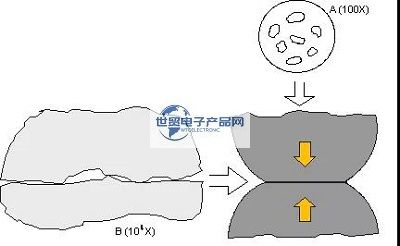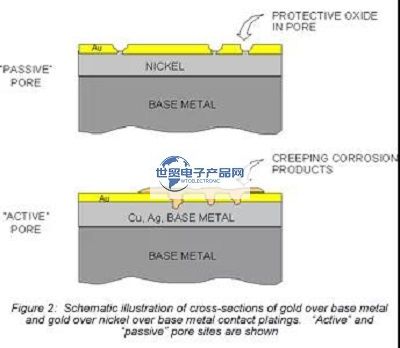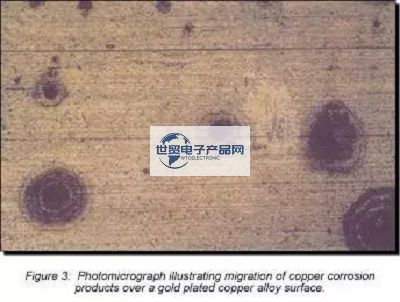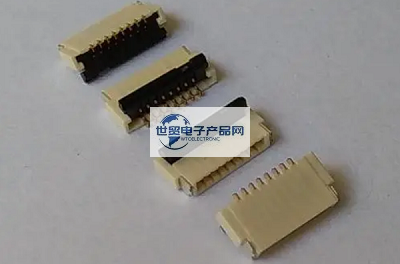Categorization:Product Information
We will continue to study and discuss the degradation mechanism of the connector. In this article, we will focus on the effect of corrosion on contact resistance in noble metal contact systems, especially at the gold-plated interface. The key is to discuss the importance of the nickel underlayer under the gold layer and its benefits to improve the performance of the gold plated connector. In the first article, the bump model of the contact interface is introduced. For convenience, refer back to Figure 1 and Figure 2 in the first article. The key point of the bumpy model is that the contact points are small, on the order of microns in diameter, and are distributed over the interface contact area, as well as the contact area created by deformation during occlusion. The current passing through the contact interface must pass through the uneven contact point, resulting in a resistance called the constriction resistance. The size of the constriction resistance depends on the number, size, and distribution of the bump contacts, etc., because all the bump contacts are electrically parallel. When all the bumpy contact interfaces are metal-to-metal, such as gold-to-gold or tin-to-tin, the constriction resistance is present even in the ideal case. If any of the uneven interfaces are covered with corrosion or contamination, the shrinkage resistance increases. This is why corrosion is an important cause of connector degradation. Loss of a bumpy contact surface or a bumpy contact due to corrosion or contamination can result in an increase in contact interface resistance sufficient to cause a connector to fail.
---------------------------------------------------------------------------------------------------
Now, let's discuss the corrosion of gold plated connectors. As we all know, gold is a precious metal, in other words, it is a non-corrosive metal; because of this property, gold is widely used in jewelry. Despite this feature, it does not mean that gold-plated connectors are not susceptible to corrosion. A connector is an electromechanical system that provides electrical performance through a mechanical system. The two separate systems of the mechanical system need to be mated and contacted, etc. Gold-plated connectors consist of a gold-plated surface and a nickel underlayer on a copper alloy material to optimize the contact surface. The copper alloy material provides the necessary resiliency for the connector to mate. The corrosion source in the system is the copper alloy material. Copper reacts chemically with oxygen, sulfur, and chlorine, all of which are common in connector applications. Therefore, with respect to corrosion susceptibility, connector design must address how to eliminate or reduce copper corrosion and ensure that any species that form corrosion cannot be placed at the connector contact interface. This is easy in theory, but a challenge in practice. If the connector manufacturer fully plates the connector with 5 microns of gold, there is no corrosion problem in the connector. However, for cost reasons, most of the plating is between 0.25 and 0.75 microns, and it is usually only the contact interface that is plated. Considering the cost factor, it is common to choose copper as the connector material. Selective plating, as well as other manufacturing processes, may result in bare copper or bare edge copper. When defects are present in the gold plating, the thin plating results in potential copper exposure. In addition to these sources of corrosion, wear of the gold plating during the life of the connection of the connector, or disturbance of the contact interface during use, must also be taken into account. All of these issues are often overlooked, and gold-plated connectors with nickel underlayers need to be properly evaluated.

---------------------------------------------------------------------------------------------------
The first problem inside the connector comes from the plating thickness. Fig. 2 schematically illustrates the variation of the condition of the gold plated surface with and without the nickel underlayer. Any defect in the gold plating process will result in the exposure of the copper alloy material. Plating defects include porosity, scratches, and contamination prior to plating resulting in incomplete plating, etc. The potential for all of these defects increases with decreasing plating thickness. Given the presence of these coating defects, any exposed copper alloy will react with the application environment and form corrosion products that can enter the coating surface. As a simple example, the copper sulfide corrosion product shown in figs. 2 and 3 migrates, or creeps, on the metal surface. Fig. 2 shows that corrosion products migrate to the surface along the wall at the pore site. Fig. 3 is a photomicrograph of a corrosion migration ring on a gold-plated copper alloy surface. If the contact interface contains any of the corrosion product rings shown in Figure 3, the interface resistance is likely to change somewhat. However, the use of a nickel underlayer can both inhibit corrosion and reduce corrosion creep. Nickel forms a very thin inert and passivating oxide that does not migrate. In effect, the nickel passivates the underlying layer of the defect, so no corrosion products migrate to the surface.

---------------------------------------------------------------------------------------------------
An additional benefit of the nickel underlayer of the relevant thickness is that it serves as a diffusion barrier. Copper diffuses easily through gold, and if the diffused copper reaches the gold-plated surface, it will form a corrosion film on the surface, which may hinder contact with the gold-plated metal surface. Copper diffusion is much slower with a nickel underlayer, and the nickel underlayer is usually thicker than the gold plating layer, so the rate of copper diffusion to the gold surface is significantly reduced. Since the diffusion rate increases with temperature, the benefit of nickel is more pronounced if the connector is used in higher temperature applications. The passivation and migration inhibition properties of nickel are also beneficial for selective plating. Surface and edge corrosion (and associated corrosion creep with the contact interface) will be minimized if the copper alloy material is integrally plated with nickel prior to selective gold plating of the contact interface. In addition to these problems, the potential corrosive effects of wear on the coating are also influenced by the characteristics of the nickel underlayer. As previously described, the contact interface is damaged due to fretting of the contact interface during the mating cycle of the connector due to mechanical or thermal expansion driving forces. Nickel has two benefits as a wear reduction factor. The first benefit is the passivation and migration inhibition properties of nickel that we discussed earlier. The wear of the gold and the exposure of the nickel underlayer will not result in a reduction in the corrosion concerned; the exposed nickel may result in an increase in the contact resistance, but the magnitude of this increase will be much smaller than that which would occur due to the corrosion effect. The second benefit is improved wear resistance of the contact plating layer. The effects of wear will be discussed in more detail in a later article. It is sufficient to understand that the nickel underlayer will increase the effective hardness of the contact coating. The gold plating used on the connector is commonly referred to as hard gold and has a hardness of about 200 knoops. The hardness of the nickel underlayer is typically 400 Knoop or more. Therefore, as the surface hardness increases, the effective hardness of the coating increases and the wear rate tends to decrease. Given the importance of the nickel underlayer to the performance of the connector, what thickness of nickel is required? Typical nickel thicknesses in gold plated connectors range from 1.25 to 4.0 microns. The lower limit is to ensure sufficient thickness to meet the requirements, and the upper limit is to consider cost and mechanical factors. The cost issue is due to the fact that more nickel means more plating time and material costs. Mechanical considerations are more complex. As the thickness of nickel plating increases, the ductility of nickel tends to decrease and the roughness of the coating tends to increase. The reduced ductility results in cracking of the coating, increased roughness, and reduced porosity and wear properties. In conclusion, the importance of the nickel underlayer in gold-plated connector systems cannot be overemphasized. Passivation of nickel is of great significance to slow down the formation and migration of corrosion products on the surface of contact material copper. In addition, nickel provides a diffusion-resistant barrier against migration of the underlying metal at the contact interface. The hardness of nickel is of great significance to improve the wear resistance, service life and fretting wear resistance of the gold-plated contact system. In view of these advantages, any gold-plated connector should be specified with a nickel-plated substrate.
---------------------------------------------------------------------------------------------------
2、 on the World Trade Electronic Products Network Platform and Sales Product Profile: World Trade Electronic Products Network-professional agent/production/sales of various { connector | harness | cable products }; If you have relevant [connector | harness | cable products] procurement/purchase needs or want to buy/know what connector | harness | cable products solutions we can provide, please contact our business personnel below; if you have relevant [connector | harness | cable products] sales/resources and promotion needs, please click "Business Cooperation ←" to negotiate with the specialist!